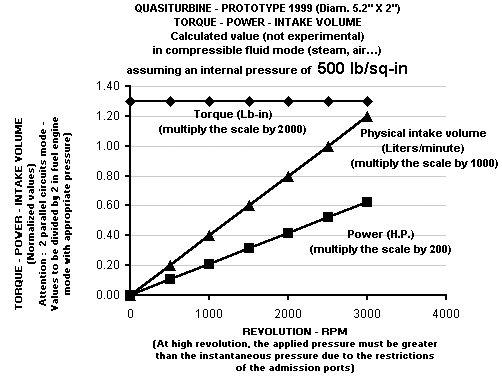Quasiturbine for nuclear steam,
nuclear power and nuclear electricity
Powerplants, ships or submarines !
For a thermal energy efficiency superior to 50% !
Since water requires
an important quantity of latent vaporization
heat
(which is not generally recover in the condenser or in the atmosphere open circuit),
operation with saturated
steam will always gives low efficiency (5 %)
(unless with a
cogeneration application),
because of the important volume of water which needs to be evaporated to maintain the
pressure.
Even if the Quasiturbine can accept saturated steam,
it is not suitable from the energy efficiency stand point,
that this steam stays saturated during all the cycle.
In fact, in all expansion thermal machine (the Quasiturbine being one of the most
efficient),
increase in thermal efficiency is always links to steam overheating (without having
to increase the pressure),
since then one gets the same pressure effect with less molecules,
wherein making a substantial reduction in the quantity of water needed to be
vaporized
(... and saving of the corresponding latent heat energy).
With an important overheating,
the efficiency of the thermal steam engines can reach and even exceed 50% ...
(The overheating may occur in the steam pipes, or in the Quasiturbine itself).
To findout more, see the technical document at the section :
Why is the Quasiturbine revolutionizing the use of steam and solar energy ?
http://quasiturbine.promci.qc.ca/QTvapeurPourquoiE.html

Quasiturbine Model QT50AC (With carriages)
Assuming a pressure differential of 500 lb/sq.in., this graph gives for each rpm
:
the engine torque, the power and the geometric intake flow.
Those result can be scaled linearly for other pressure differentials.
In practice, divide the torque and power by 2 to account for the form factor
would provide more realistic results.
Using this graph to scale up hypothetical large steam units
at 33 bars (500 psi) differential
and at a reduced speed of 1800 RPM would gives
(no experimental data yet available) :
| Shaft Power |
Rotor diameter |
Rotor thickness |
| 50 kW (70 HP)
0,4 MW (530 HP)
3 MW (4 000 HP)
25 MW (33 000 HP)
200 MW (260 000 HP)
|
13 cm (5 inches)
25 cm (10 inches)
53 cm (21 inches)
1 m (3,5 feet)
2 m (7 feet)
|
5 cm (2 inches)
10 cm (4 inches)
20 cm (8 inches)
41 cm (16 inches)
82 cm (32 inches)
|
Notice that in 4 strokes internal combustion mode, the
Quasiturbine power is about 1/8 of the one indicated,
increasing with the maximum RPM.
In practice, divide the torque and power by 2 to account for the form factor
would provide more realistic results.
The Quasiturbine technology is listed by
INIS © International Atomic Energy Agency
Wagramer Straße 5 P.O.Box 100 A-1400 Vienna
AUSTRIA
http://www.iaea.or.at/programmes/inis/ws/d2/r1785.html
Quasiturbine for Cold Fusion Heat ?
Super abundant vacancies 3-bodies fusion explanation !
(Reported by Kemykle Kemykle@hotmail.com
)
Recent results in metallurgy and hydrogen storage in palladium and other metals
suggest that several deuterium atoms can be squeezed closer together in
vacancies than in deuterium molecules.
This suggests a possible mechanism for cold fusion which lies within the
framework of present-day physics.
Super abundant vacancies filled with hydrogen (deuterium) occur in
many transition period metals (palladium, iron, nickel, copper) at high
temperature and hydrogen pressure.
This has been shown by the group of Fukai, a major authority on hydrogen in
metals;
the superabundant phase seems to be the thermodynamically stable phase under
these conditions.
Under ordinary laboratory conditions super abundant vacancies form when metals
are deposited electrolytically.
In some cases the hydrogen filled vacancies form a regular lattice like the
Cu3Au lattice: Ni3Vac,
that can be observed by x-ray diffraction. There are large disagreements about
how many
hydrogen/deuterium can sit in such a vacancy of about 10 cubic-angstroms, and
how close they can sit together.
The classical opinion is 6 deuteriums, sitting further from each
other
than in the deuterium molecule (Nordlander et al. 1989);
more recent research suggests 2 or 3 (4) deuteriums.
However, 3 D's should sit only 0.32 angstrom,
and 4 deuteriums only 0.25 angstroms from each other (Tateyama and Ohno 2003)??
It is known that if two deuterons are placed
within 0.1 angstrom
of each other the fusion rate would be about one million per sec per mole (Cottingham
1989).
It is also known that that three-body boson (efimov) interactions can have
longer range than two boson interactions.
Deuterium filled super abundant vacancies would open up for multibody fusion
as suggested by Takahashi of Osaka University (Isobe, Takahashi 2002) according
to the following schemes:
D + D + D -> helium-4 + D, D + D + D -> tritium + helium-3, and D + D + D + D ->
4-helium + 4-helium.
The multibody fusion hypothesis explains rather neatly the
observations that cold fusion yields mainly helium-4, much less tritium and
almost no neutrons.
The super abundant vacancy hypothesis explains the long lagphases before cold
fusion is observed,
and it explains why cold fusion is best observed when palladium is deposited
electrolytically together with deuterium as observed by Miles (lenr-canr site).
This could be applied to the ultrasound fusion experiments in deuterated acetone
where there is no lattice.
Perhaps there is a possibility in the experiments in D2O if palladium or
titanium metal is present.
References: http://lenr-canr.org .
Fukai, Y. (2003) J. Alloys Compounds 356-357, 263-269.
Cottingham (1989) J. Physics G. 15, L157.
Nordlander et al. (1989) Phys. Rev. B. 40, 1990-1992,
Tateyama and Ohno (2003), Phys. Rev. B 67, 174105.
Isobe Takahashi et al (2002) Japn. J. Appl. Physics 41, 1546-1556.
This will produce a lot of heat and steam for the
Quasiturbine to transform in electricity !
Quasiturbine Vapeur Inc.
Casier 2804, 3535 Ave Papineau, Montréal Québec H2K 4J9 CANADA (514) 527-8484 Fax (514)
527-9530
http://quasiturbine.promci.qc.ca
quasiturbine@promci.qc.ca
